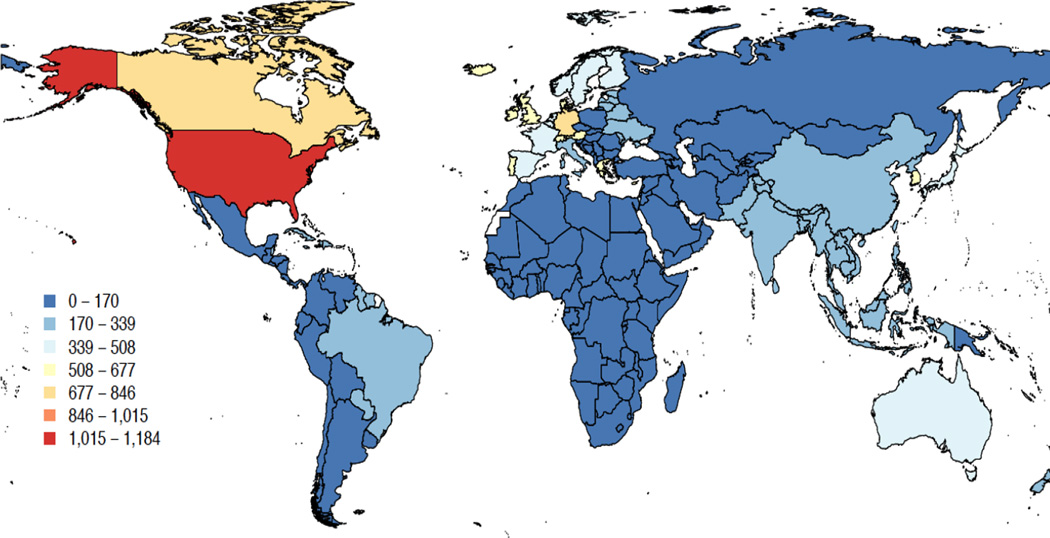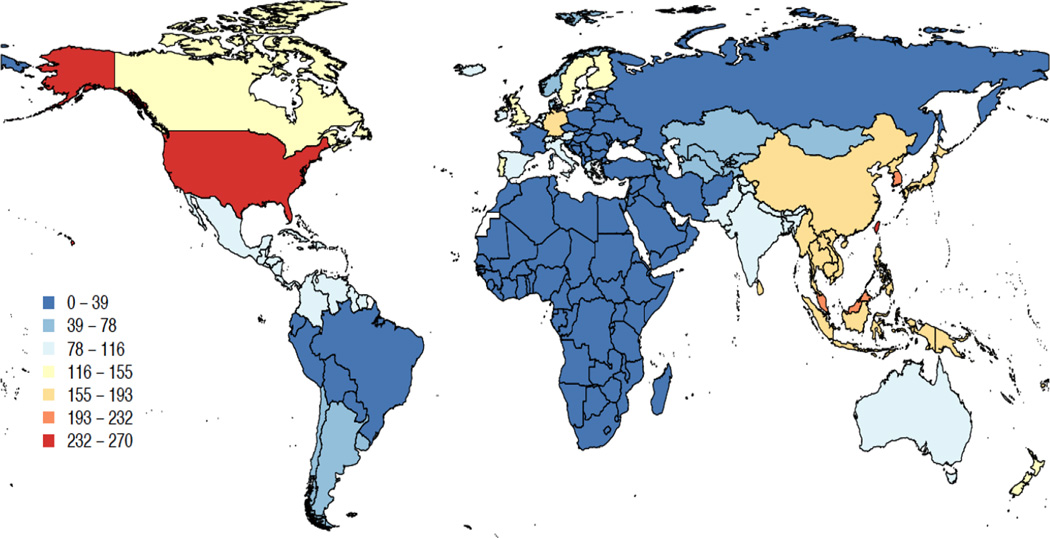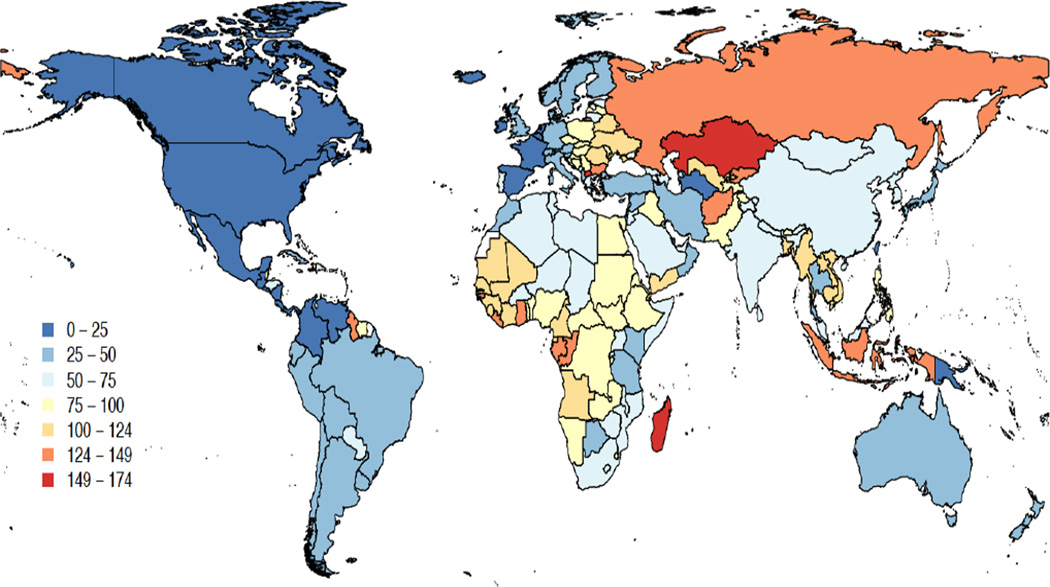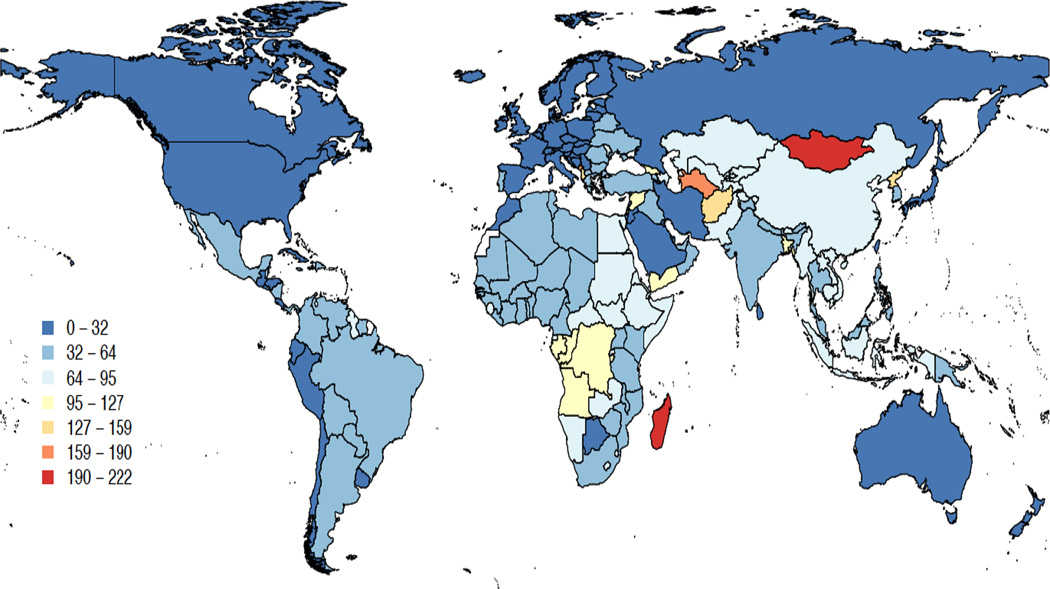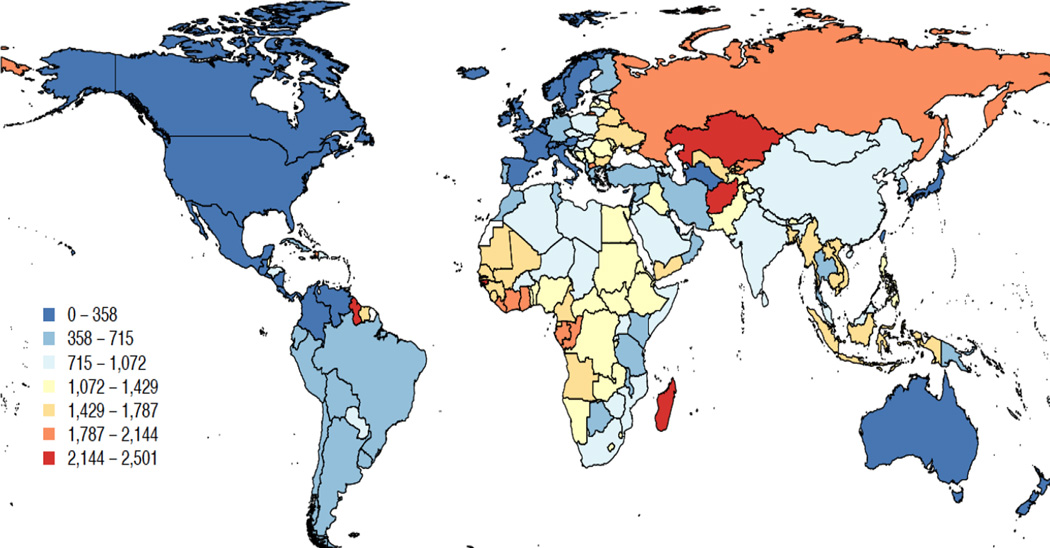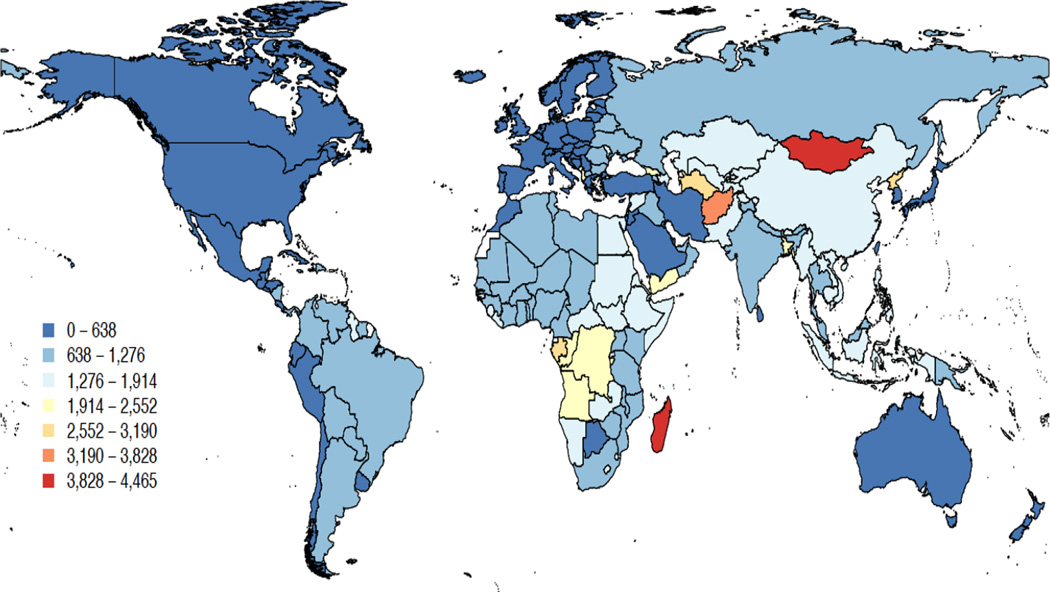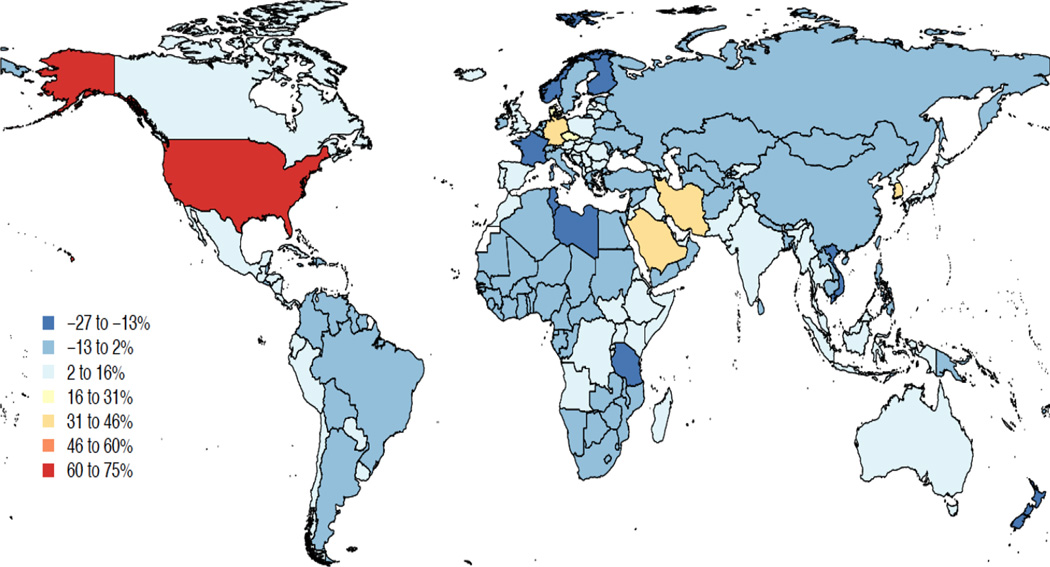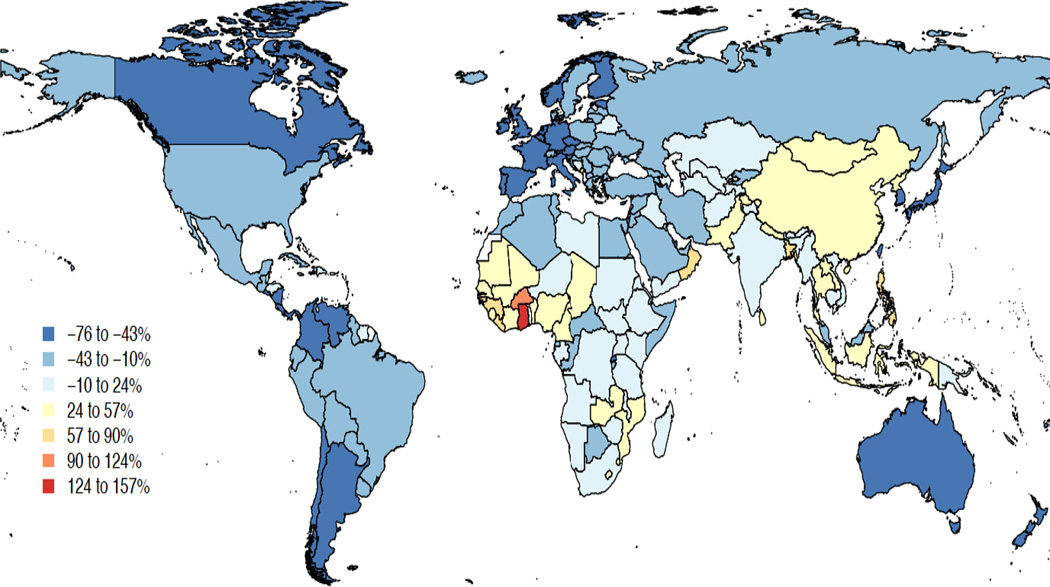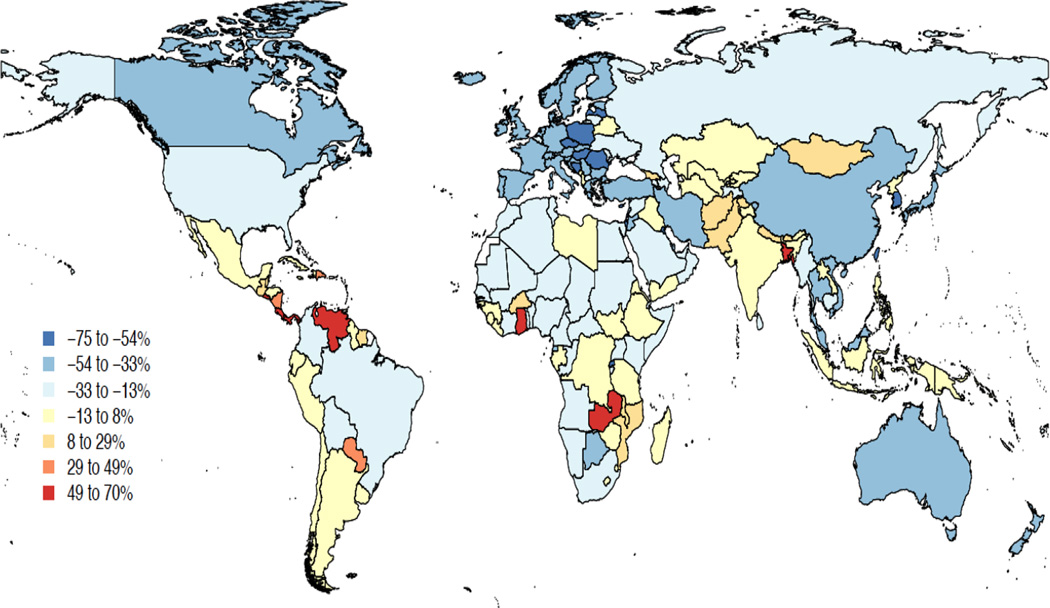Synopsis
Background
World mapping is an important tool to visualize stroke burden and its trends in various regions and countries.
Objectives
To show geographic patterns of incidence, prevalence, mortality, disability-adjusted life-years (DALYs) and years lived with disability (YLDs), and their trends for ischemic stroke (IS) and hemorrhagic stroke (HS) in the world for 1990 to 2013.
Methodology
Stroke incidence, prevalence, mortality, DALYs and YLDs were estimated following the general approach of the Global Burden of Disease (GBD) 2010 with several important improvements in methods. Data were updated for mortality (through April 2014) and stroke incidence, prevalence, case fatality, and severity through 2013. Death was estimated using an ensemble modelling approach. A new software package, DisMod-MR 2.0 was used as part of a custom modelling process to estimate YLDS. All rates were age-standardized to new GBD estimates of global population. All estimates have been computed with 95% uncertainty intervals (UI).
Results
Age-standardized incidence, mortality, prevalence and DALYs/YLDs declined over the period from 1990 to 2013. However, the absolute number of people affected by stroke has substantially increased across all countries in the world over the same time period, suggesting that the global stroke burden continues to increase. There were significant geographical (country and regional) differences in stroke burden in the world, with the majority of the burden borne by low- and middle-income countries.
Conclusions
Global burden of stroke has continued to increase in spite of dramatic declines in age-standardized incidence, prevalence, mortality rates, and disability. Population growth and ageing have played an important role in the observed increase in stroke burden.
Keywords: stroke, atlas, burden, GBD 2013
1.
Age-standardized annual prevalence (per 100,000) of ischemic stroke in 2013
2.
Age-standardized annual prevalence (per 100,000) of hemorrhagic stroke in 2013
3.
Age-standardized annual mortality rates (per 100,000) of ischemic stroke in 2013
4.
Age-standardized annual mortality rates (per 100,000) of hemorrhagic stroke in 2013
5.
Age-standardized annual DALYs rates (per 100,000) due to ischemic stroke in 2013
6.
Age-standardized annual DALYs rates (per 100,000) due to hemorrhagic stroke in 2013
7.
Percent change in age-standardized prevalence due to ischemic stroke for 1990–2013
8.
Percent change in age-standardized prevalence due to hemorrhagic stroke for 1990–2013
9.
Percent change in age-standardized mortality rates due to ischemic stroke for 1990–2013
10.
Percent change in age-standardized mortality rates due to hemorrhagic stroke for 1990–2013
Acknowledgements
This work was undertaken as a part of the Global Burden of Diseases, Injuries, and Risk Factors (GBD 2013) study. We thank Sarah Safranek, University of Washington Health Sciences Library, for her help in developing the systematic review literature search strategies; Michael F. MacIntyre, Brittany Wurtz and Summer Ohno, University of Washington Institute for Health Metrics and Evaluation, for research coordination; Ryan M. Barber, University of Washington Institute for Health Metrics and Evaluation, for creating figures and tables for the paper; Hannah Gardener, University of Miami, for helping reviewing some studies; and Helen McDonald, AUT University National Institute for Stroke And Applied Neurosciences, for organising teleconferences and secretarial support. The authors alone are responsible for the views expressed in this publication.
Role of the funding source
Funded by the Bill and Melinda Gates Foundation. The sponsor of the study had no role in the study design, data collection, data analysis, data interpretation, or writing of the report. The GBD 2013 Core investigators had access to all data sources and has responsibility for the content of the report and the decision to submit for publication.
Appendix
GBD Stroke Collaborators (in alphabetical order by country)
Argentina (Maria Cecilia Bahit); Australia (Amanda Thrift, Atte Meretoja, Bill Stavreski, Craig Anderson, Edwin Pearse, Geoffrey Donnan, Graeme Hankey, Mark T. Mackay, Stephen Davis, Zanfina Ademi; Austria (Michael Brainin); Azerbaijan (Tural Guliyev); Bahrain (Randah R. Hamadeh); Barbados (Heather Harewood, Karen Springer); Brazil (Iuri da Costa Leite, Jefferson Gomes Fernandes, Norberto Cabral, Paulo Lotufo); Bulgaria (Klara Dokova); Canada (Farshad Pourmalek, Luciano A. Sposato, M. Patrice Lindsay, Patricia Riccio); Chile (Pablo M. Lavados); China (Bin Li, Chuanhua Yu, Guohong Jiang, Jixiang Ma, Maigeng Zhou, Ming Liu, Shankuan Zhu, Wenzhi Wang, Xiaofeng Liang, XXX Deji, Yong Zhang); Colombia (Gabriel Alcalá-Cerra, Gabrielle DeVeber), Denmark (Hanne Christensen, Thomas Truelsen); Egypt (Foad Abd-Allah); Ethiopia (Awoke Temesgen, Berhe Weldearegawi Sahle, Semaw Abera, Yohannes Adama Melaku), Fiji (Devina Nand); France (Maurice Giroud); Germany (Jost B. Jonas, Matthias Endres, Ronny Westerman); Greece (Konstantinos Stroumpoulis); India (Dorairaj Prabhakaran, Jeyaraj Durai Pandian, Man Mohan Mehndiratta, Nobhojit Roy, Panniyammakal Jeemon, Rajeev Gupta, Vasanthan Rajagopalan); Indonesia (Soewarta Kosen, Tati Suryati Warouw); Iran (Reza Malekzadeh); Ireland (Martin O'Donnell); Israel (David Tanne, Natan Bornstein); Italy (Stefano Ricci, Valeria Caso); Japan (Yoshihiro Kokubo, Yukito Shinohara); Jordan (Majed Asad); Kenya (Vitalis Kizito Bwire); Korea (Sun Ha Jee, Young-Ho Khang); Malaysia (Kim Yunjin, Ramesh Sahathevan); Morocco (Fortune Gankpe); Myanmar (Chaw Yin Myint); New Zealand (Priya Parmar, Rita Krishnamurthi, Suzanne Barker-Collo, Valery Feigin); Nigeria (Rufus Olusola Akinyemi); Norway (Ole Norheim); Qatar (Shams Eldin Khalifa); Russia (Michael Kravchenko, Michael Piradov, Nicolay Shalamov, Vasiliy Vlassov, Yuri Varakin); Rwanda (Jean De Dieu Ngirabega, Jean Pierre Nyemazi, Marie Aimee Muhimpundu); Saudi Arabia (Mohammad Saeedi, Neeraj Bedi); Singapore (Narayanaswamy Venketasubramanian); South Africa (Andre Pascal Kengne); Spain (David Rojas-Rueda, Ferrán Catalá-López); Sri Lanka (Samath Dharmaratne); Sweden (Bo Norrving, Rasmus Havmoeller); The Netherlands (Johanna M. Geleijnse); Uganda (Leo Atwine); United Kingdom (Amitava Banerjee, Charles Wolfe, Derrick Bennett, Finbar O'Callaghan, Ivy Shiue, Julia Critchley, Majid Ezzati, Michael Soljak, Myles Connor, Peter Rothwell, Rajiv Chowdhury, Rustam Al-Shahi Salman, William Whiteley, Zhengming Chen); Uruguay (Mercedes Colomar); USA (Adnan Durrani, Anand Dayama, Andrew Moran, Awoke Misganaw, Brett Kissela, Catherine Amlie-Lefond, Catherine O. Johnson, Cheng Huang, Chugh Sumeet, Daniel Kim, David Cundiff, David Lawrence Tirschwell, Dhruv Kazi, Dima Qato, Edmond Kabagambe, Eric Ding, Gene Bukhman, Gene Kwan, George Mensah, George Thurston, Grant Nguyen, Gregory A. Roth, Ismael Campos-Nonato, Josef Coresh, Kate Lefondulq, Kevin Sheth, Matthew Corriere, Mohammad H. Forouzanfar, Mohsen Naghavi, Nana Mainoo, Norman Beauchamp, Ralph Sacco, Richard Gillum, Sanjay Basu, Stephen Schwartz, Sumeet Chugh, Teresa Fung, Tim Byers, Uchechukwu K.A. Sampson, Walter Rocca, Warren Lo).
Footnotes
Conflict of interest
The authors have no conflict of interest to declare.
Disclaimer: The views expressed in this article are those of the authors and do not necessarily represent the views of the National Heart, Lung, and Blood Institute, National Institutes of Health, or the U.S. Department of Health and Human Services.
Contributor Information
Valery L. Feigin, National Institute for Stroke & Applied Neurosciences, Auckland University of Technology, Auckland, New Zealand.
George A. Mensah, Center for Translation Research and Implementation Science (CTRIS), National Heart, Lung, and Blood Institute, National Institutes of Health, Bethesda, Maryland, USA.
Bo Norrving, Department of Clinical Sciences, Neurology, Lund University, Sweden.
Gregory A. Roth, Institute for Health Metrics and Evaluation and the Division of Cardiology, School of Medicine, University of Washington, Seattle, Washington, USA.



